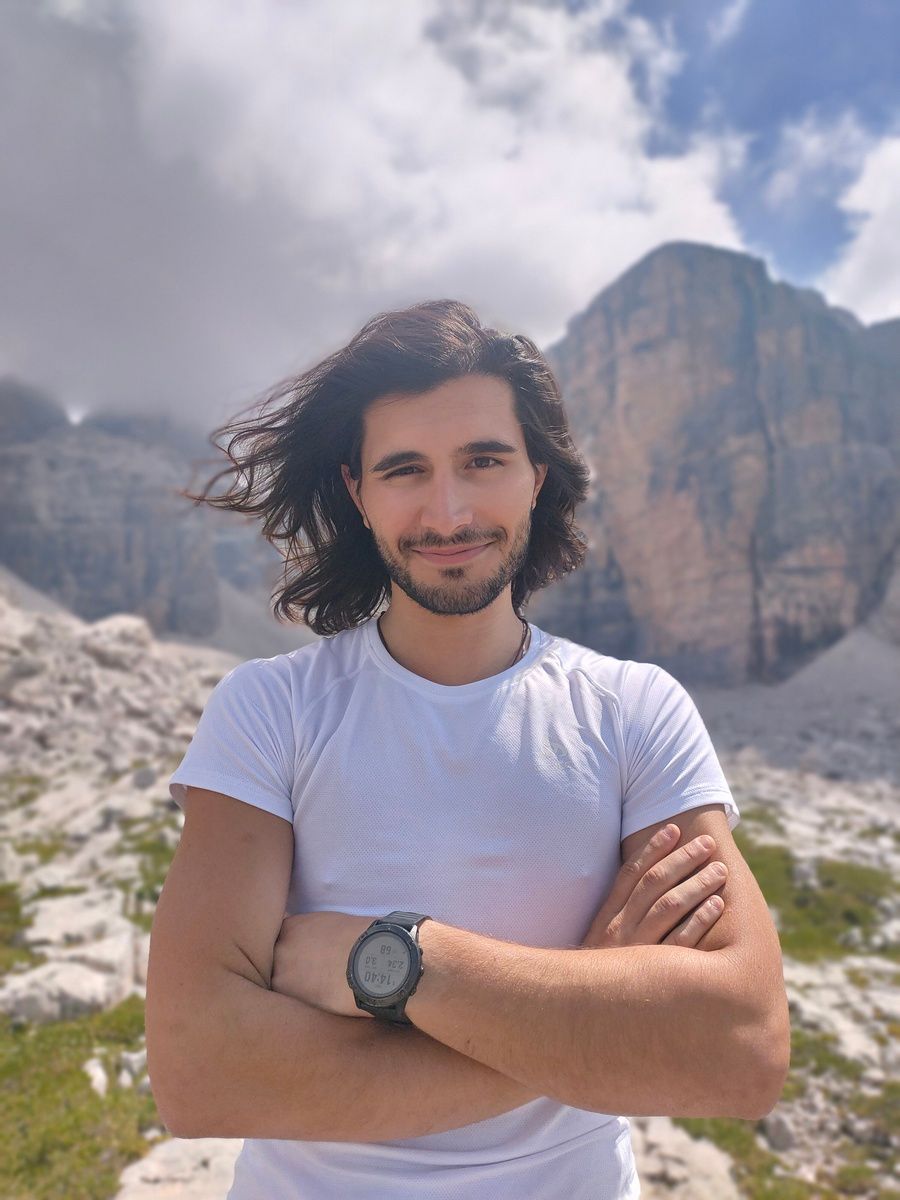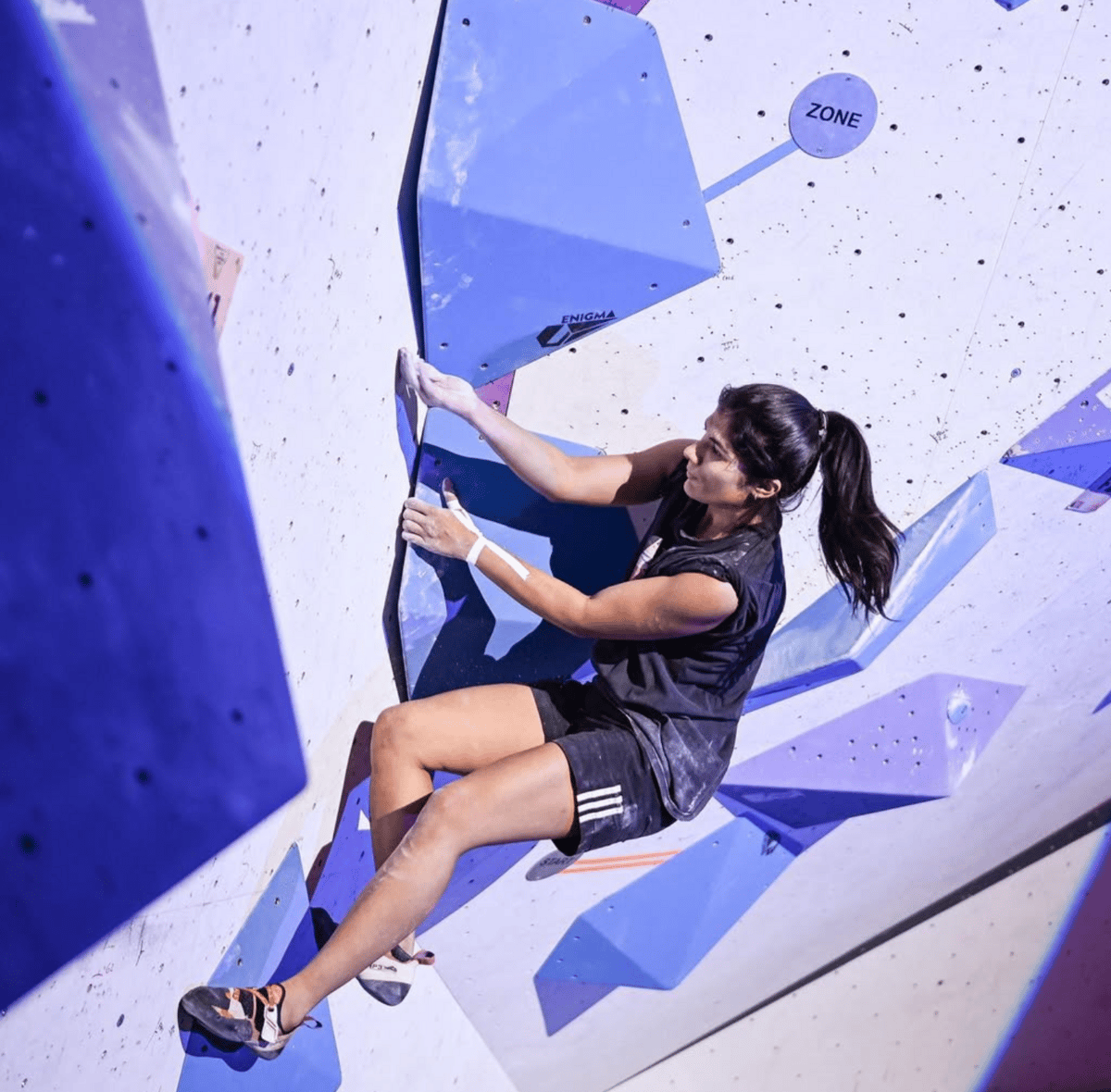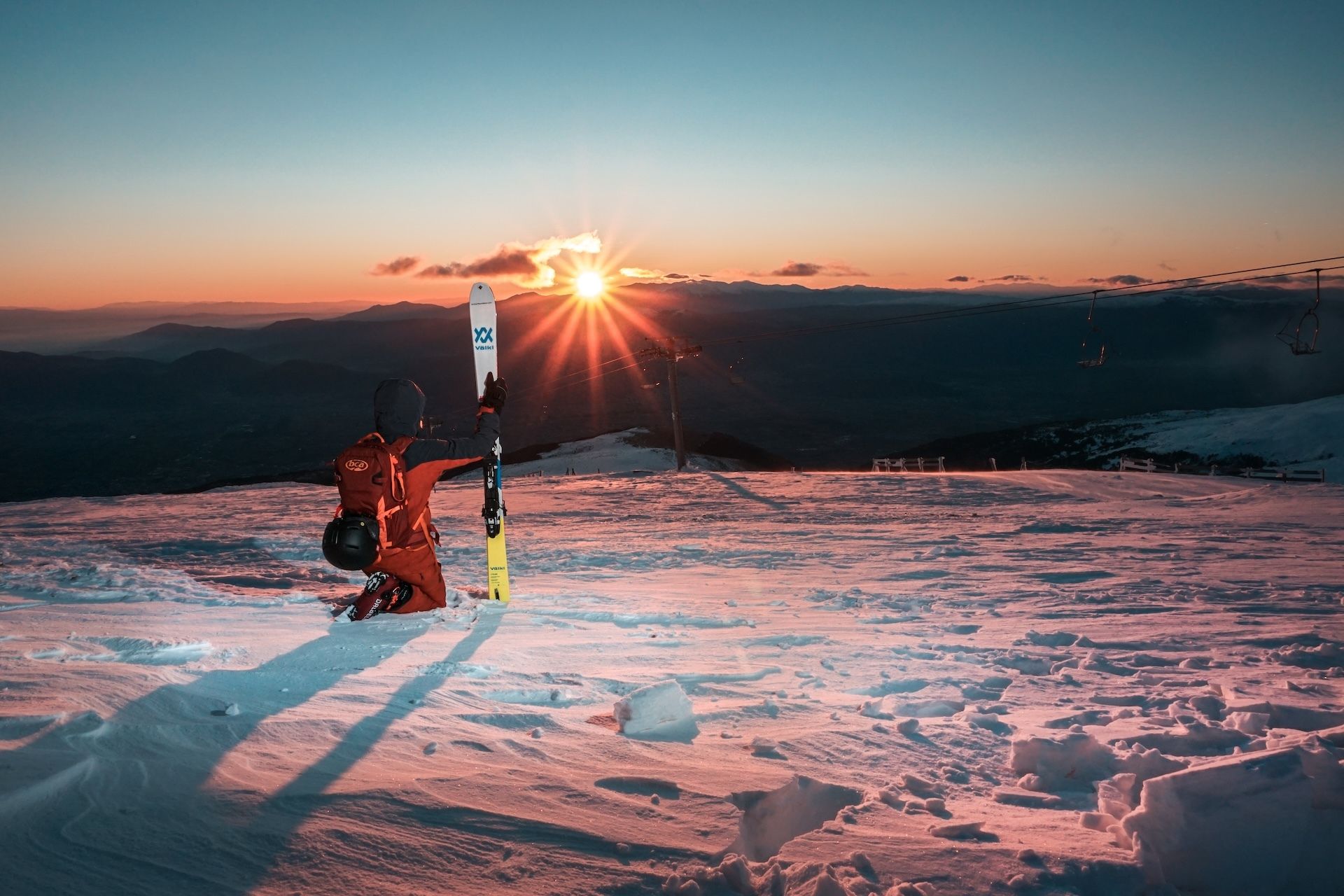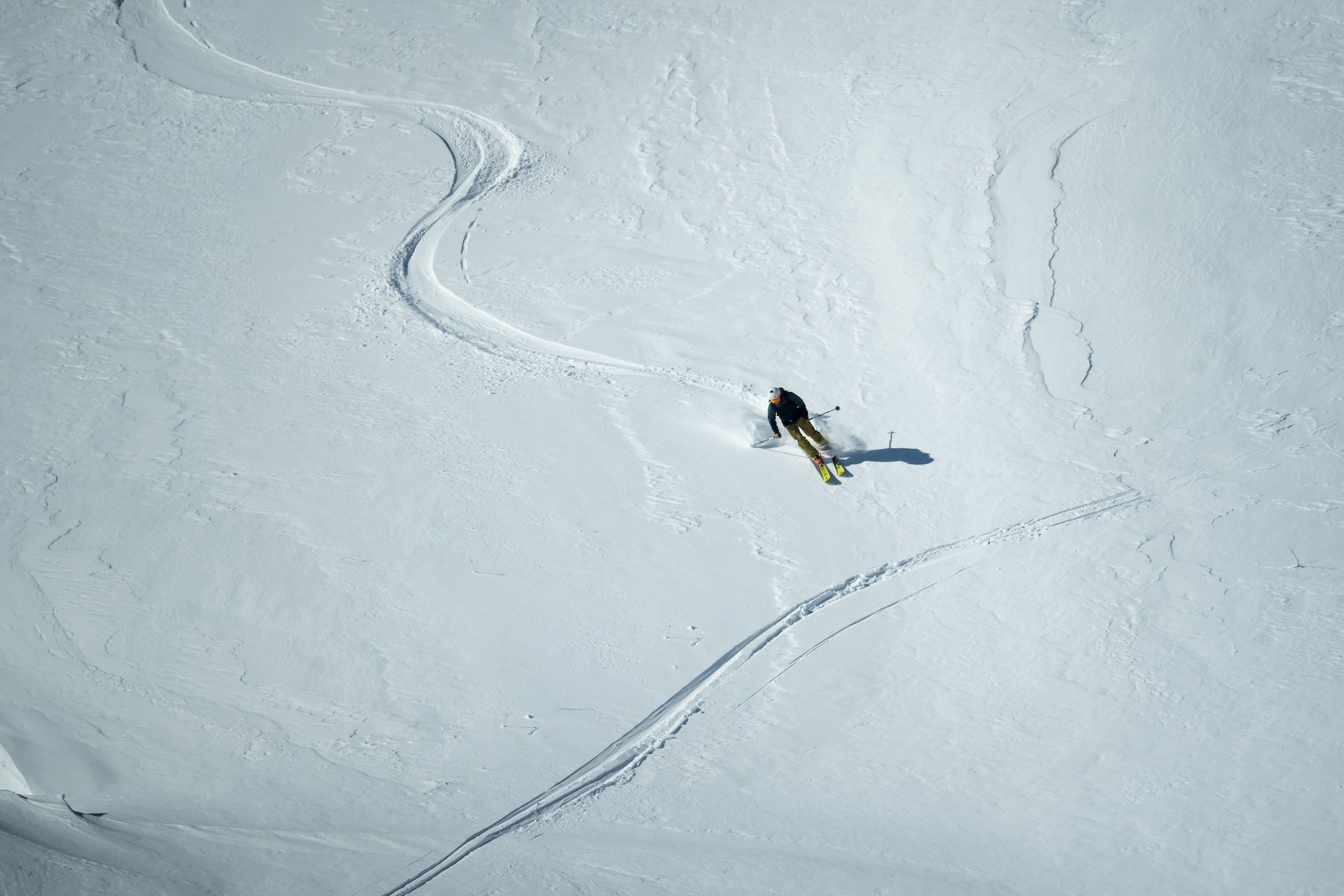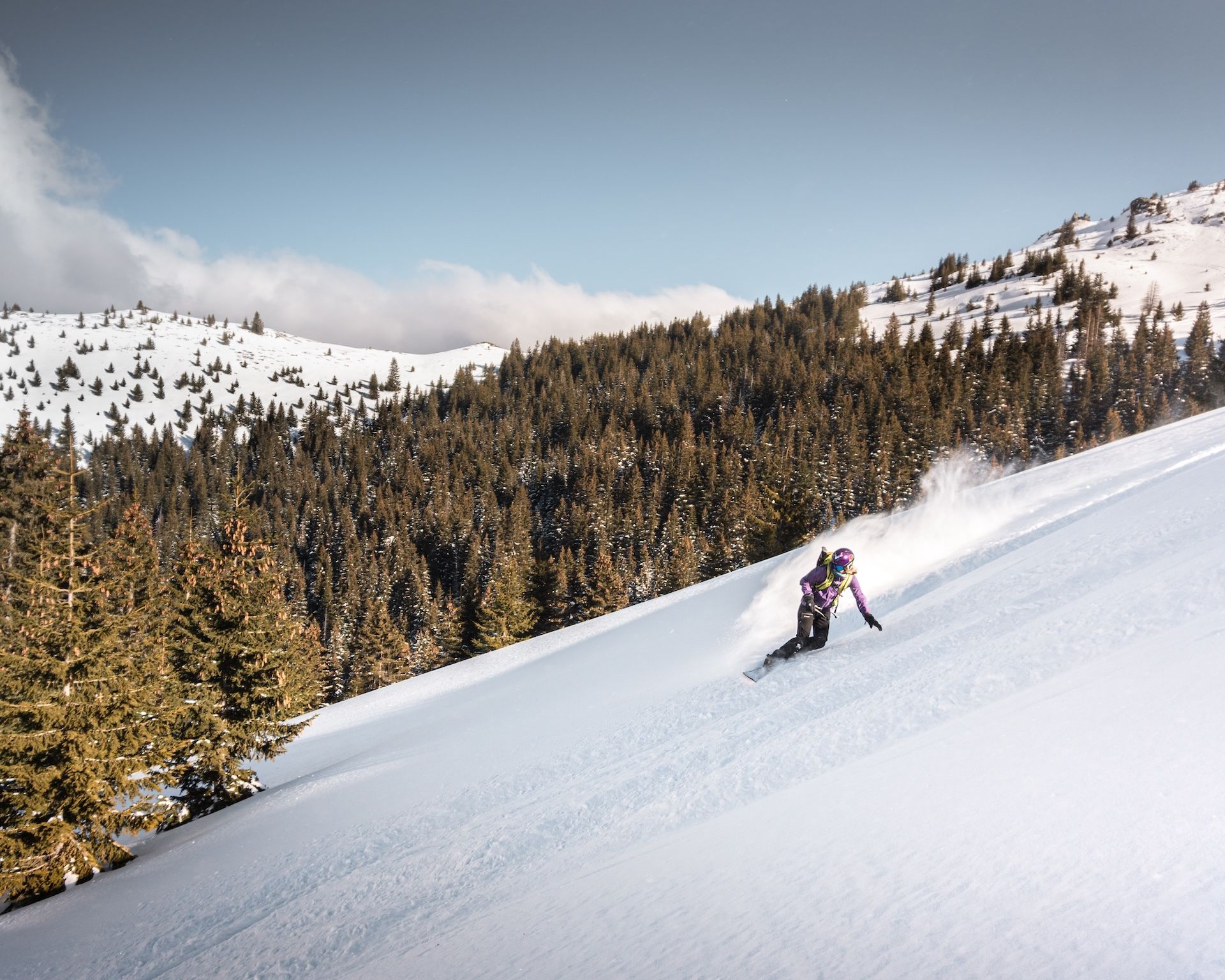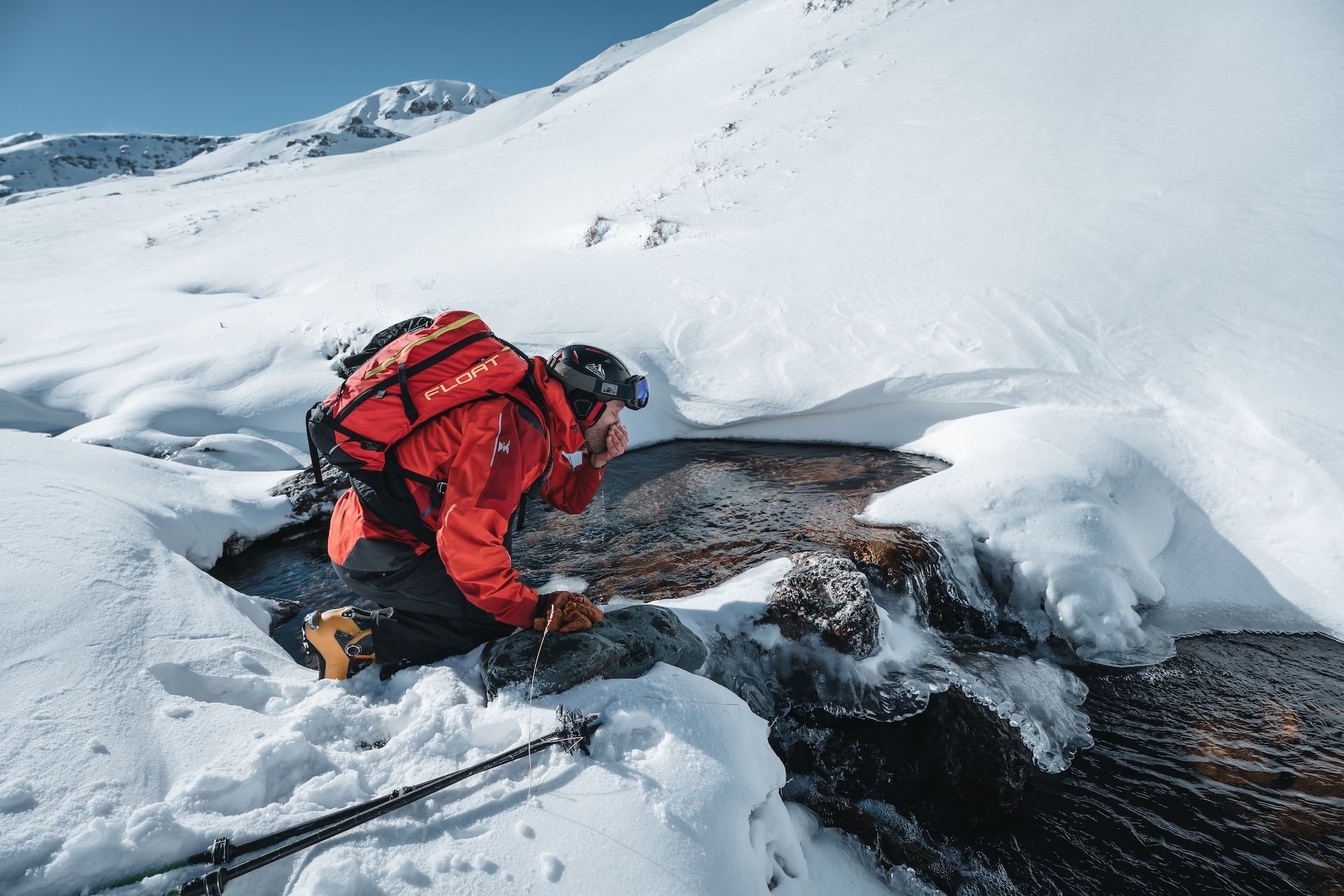When most people think of North Macedonia, they might think of the country’s cultural heritage, world-renowned archeological sites, and rich history. Very few know that the country is a haven for ski-touring enthusiasts who love off-the-beaten-path adventures.
From Mavrovo National Park, home to the country’s highest peak and breathtaking vistas, to the snow-covered pine forest trails in Pelister National Park, or traversing through the vast wilderness in the Sharr Mountains, ski-touring in North Macedonia is truly one-of-a-kind.
Although the region tends to enjoy a steady stream of snow between November and April, it is generally recommended that skiers visit between January to March. During this period, storms brought in from the Adriatic and Aegean seas ensure that there is a consistent amount of deep powder for you to revel in.
Table of contents
Chapter 1: Sharr Mountains
🏔️ Picturesque landscapes: Untouched, snow-capped peaks just waiting to be explored. Towering peaks reaching up to an impressive 2,747 metres above sea level.
💎 Hidden gem: Known as one of ski-touring’s best-kept secrets, offering off-the-beaten-path adventure
⛷ Multi-country ski adventures: The mountain region spans across North Macedonia, Kosovo and Albania, cross-border ski-adventures.
How can I get there?
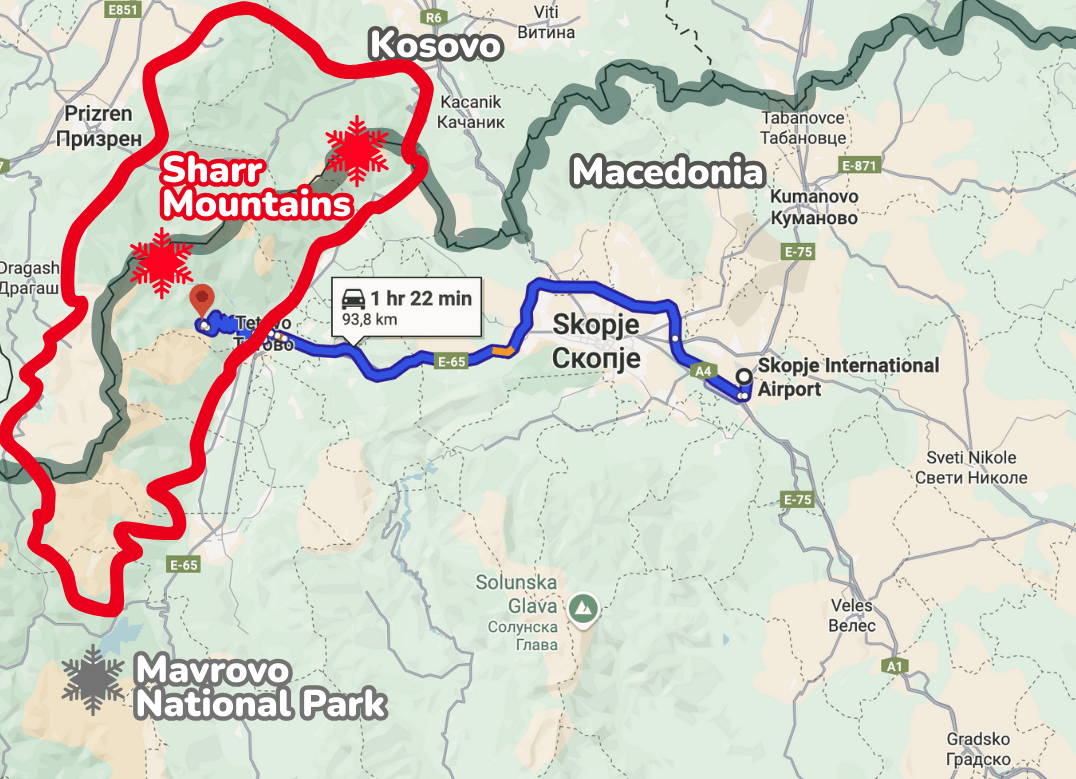
Fly to Skopje, North Macedonia, and reach Popova Šapka.
To get to the Sharr Mountains, fly into Skopje International Airport (SKP), which has connections to major cities throughout Europe.
From Skopje you can then rent a car and drive to Popova Shapka, or if you’re looking for a more sustainable ski-touring experience, you can take a bus to Tetovo and arrange a transfer on to Popova Šapka.
Popova Šapka is the main hub for winter skiing in the Sharr Mountains. However, the Sharr range extends through most of the North Macedonia-Kosovo border.
For Beginners
While it is recommended that any adventurer heading to the Sharr Mountains has a base level of fitness, many peaks feature wide, open terrain - making it the perfect destination for any newbie ski-tourer.
That being said, it is recommended that a beginner should opt for guiding services or to go with a guided tour. A guide can provide valuable knowledge on avalanche safety, varied terrain, navigation, and equipment, significantly reducing the associated risks.
Beginner-friendly routes:
Ceripashina
A gradual climb featuring scenic vistas and a gentle descent.
Elevation gain: ~700m+
Time: 2-3 hours for ascent, ~2 hours for descent.
Starting Point: 📍 Popova Šapka
Popova Šapka to Kosovo Snowfields:
A cross-border route featuring mild inclines and powdered slopes
Time: Time: 3 hours for ascent, ~2 hours for descent.
Starting Point: 📍 Popova Šapka
Popova Šapka Plateau
Wide, open terrain ideal for honing ski-touring techniques and gaining confidence.
Time: Time: 1-2 hours for ascent, ~30 minutes for descent.
Starting Point: 📍 Popova Šapka
⚠️ The information presented here might be inaccurate. Please don’t use it as a reference for your ski tours. Always consult the local guidebook or hire a professional guide.
For Experts
For seasoned ski mountaineers, the Sharr Mountains offer plenty of challenge as well. With steep runs, technical ridgelines, and untouched backcountry waiting to be explored, this range also rewards those with advanced skills and experience.
The combination of steep peaks, deep snow, and varied terrain makes it a playground not just for beginners, but for experts seeking new lines and serious adventure.
Advanced routes:
Titov Vrv (2,747m)
A very long and ascent followed by a thrilling descent through steep powder fields and ridges.
Elevation gain: ~1850m+
Time: 4-6 hours for ascent, ~2 hours for descent.
Starting Point: 📍 Popova Šapka
Kosovo Ridge Crossing
Cross-border route from Staro Selo to Ljuboten Hut into Kosovo through very technical terrain.
North Face: steep skiing and couloirs.
Elevation gain: ~1600m+
Time: 4-6 hours for ascent, ~2 hours for descent.
Starting Point: 📍Staro Selo
Ljuboten (2,498m)
Wilder alternative to Titov Vrv. Sublime views, that often stretch as far as parts of Albania.
East face: milder terrain with powder preservaition.
South face: optimal spring conditions.
Elevation gain: ~1600m+
Time: 4-5 hours for ascent, ~2 hours for descent.
Starting Point: 📍Staro Selo
👉🏼 Wikilock track (not a skiing track, but similar itinerary)
⚠️ The information presented here might be inaccurate. Please don’t use it as a reference for your ski tours. Always consult the local guidebook or hire a professional guide.
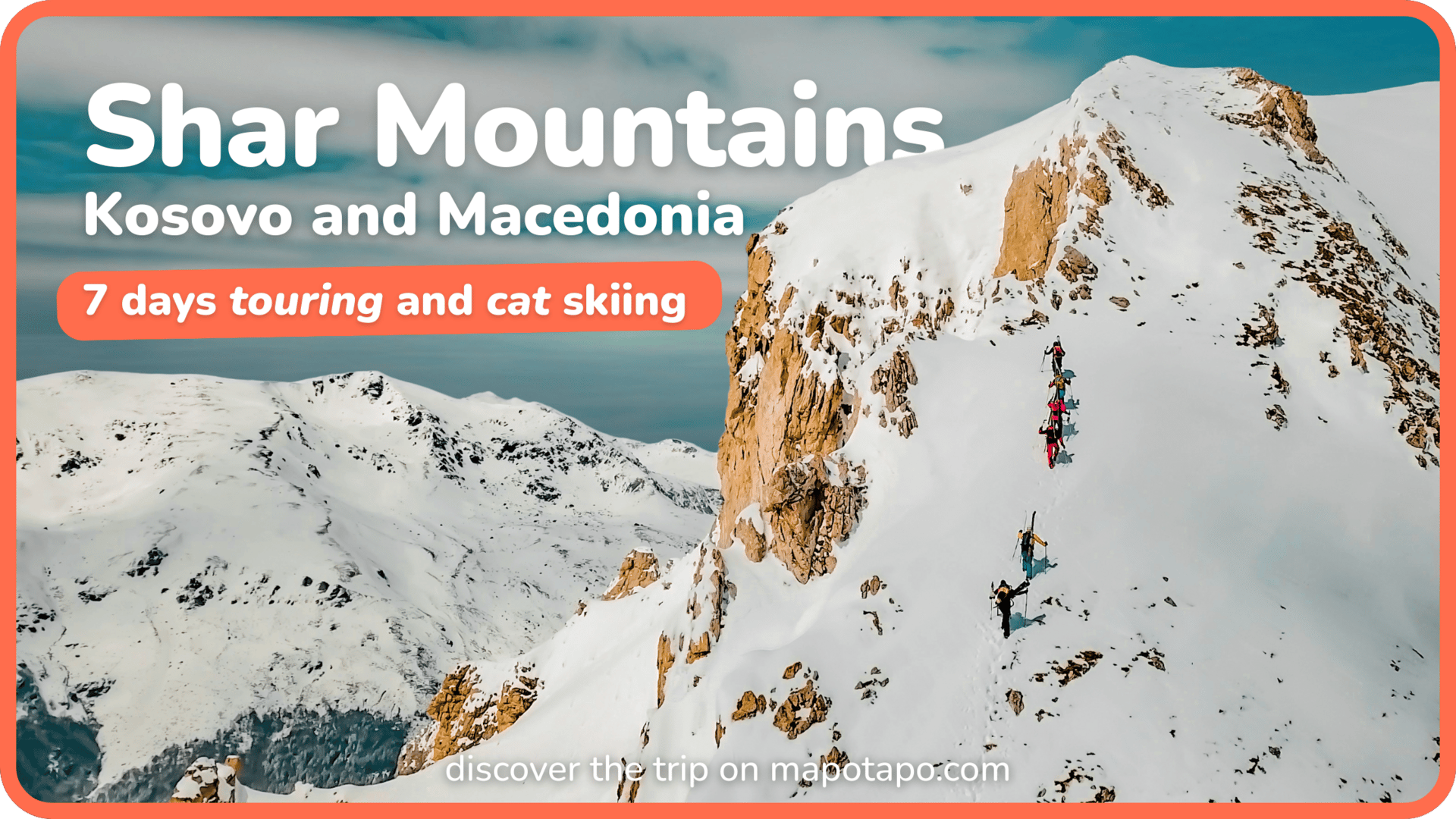
7 days touring and cat skiing between Kosovo and Macedonia. Local certified guide included. Small groups and limited spots. Departures in January and February. See more on mapotapo.com
Chapter 2: Mavrovo National Park
📸 Breathtaking vistas: Mavrovo National Park is home to massive mountains, reaching an impressive 2,764 metres above sea level. You’ll have panoramic views of the mountains along the Macedonia-Albania border.
🏰 Cultural hub: Local dishes like ajvar, a pepper dip. Live performances of traditional folk dances like the Teshkoto, the most famous Macedonian folk dance.
⛷ Suitable for all ski levels: the rolling landscapes and vast meadows mean that there’s something for everyone. Beginners can try the plateau between Lazaropole and Galichnik, an almost flat route. Experts can climb and ski the 2,764 meters Mount Korab.
How can I get there?
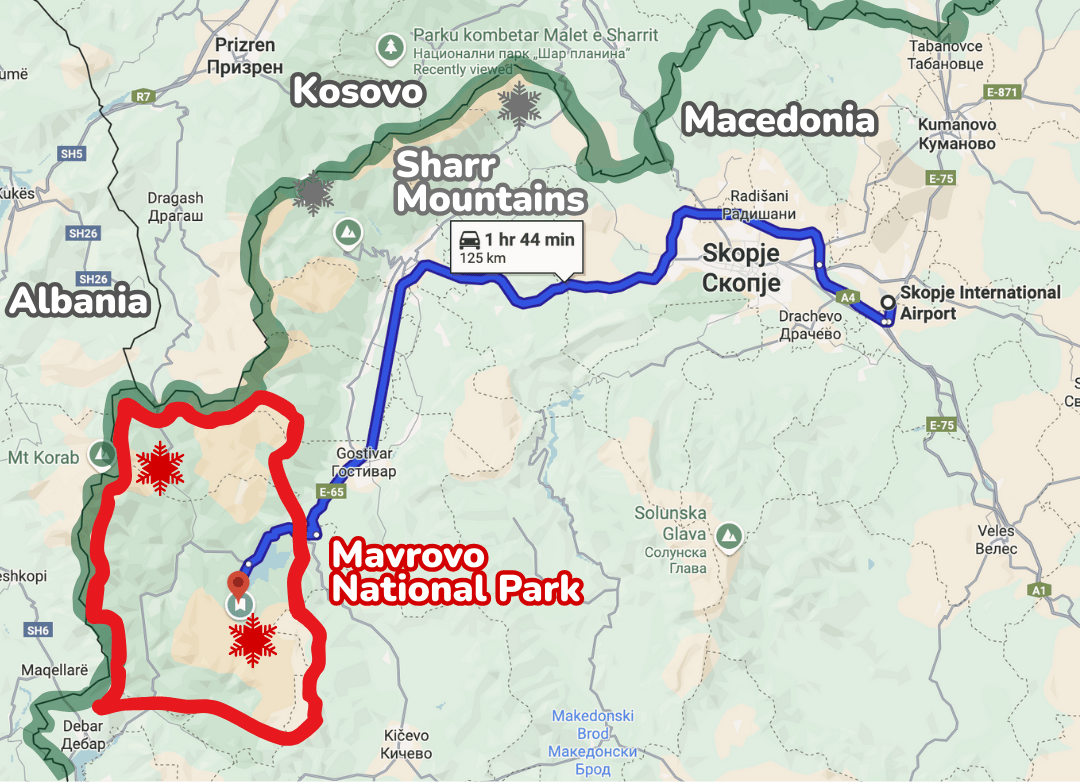
Fly to Skopje, North Macedonia, and then travel to Mavrovo.
To get to Mavrovo National Park, fly into Skopje International Airport (SKP), which has connections to major cities throughout Europe.
From Skopje you can then rent a car and drive to Mavrovo, or if you’re looking for a more sustainable ski-touring experience, you can take a bus to Gostivar and arrange a transfer on to Mavrovo.
For Beginners
Much like the Sharr Mountains, it is recommended that anyone planning on ski-touring in Mavrovo National Park has a solid base level of fitness, part of the region’s beauty is that there is something for everyone - no matter your skill level.
That being said, it is recommended that a beginner should opt for guiding services or to go with a guided tour. A guide can provide valuable knowledge on avalanche safety, varied terrain, navigation, and equipment, significantly reducing the associated risks.
Beginner-friendly routes
Lazaropole–Galichnik Plateau
A gentle route up open terrain and minimal elevation gain.
Elevation gain: ~250m+
Time: 1-1.5 hours for ascent, ~45 minutes for descent.
Starting Point: 📍 Lazaropole
Bistra Foothills
A very gradual incline, featuring jaw-dropping views of Mavrovo Lake.
Elevation gain: ~700m+
Time: 2-3 hours for ascent, ~1 hour for descent..
Starting Point: 📍 Mavrovo
Galichnik Circular Trail
Easy climb up rolling meadows, followed by moderate descents.
Elevation gain: ~700m+
Time: 2-3 hours for ascent, ~1 hour for descent.
Starting Point: 📍 Galichnik
👉🏼 Wikilock track (not a skiing track, but similar itinerary)
⚠️ The information presented here might be inaccurate. Please don’t use it as a reference for your ski tours. Always consult the local guidebook or hire a professional guide.
For experts
Mavrovo National Park is home to one of the country’s top ski resorts and its highest peak, Mount Korab (2,764 m). From deep untouched snow runs to breathtaking panoramic views, Mavrovo combines adventure with natural beauty. Whether you're an experienced rider or an enthusiastic beginner, the park’s diverse terrain offers something for everyone.
Advanced routes
Mount Korab (2,764m)
Steep ascent followed by a technical descent through powder fields and tree-lined trails.
Elevation gain: ~1450m+
Time: 4-6 hours for ascent, ~2.5 hours for descent.
Starting Point: 📍 Strezimir
Mavrovo to Albania Border Ridge
A remote, challenging route, featuring exposed ridge lines.
Time: Time: 6-7 hours for ascent, ~3 hours for descent.
Starting Point: 📍Mavrovo
⚠️ The information presented here might be inaccurate. Please don’t use it as a reference for your ski tours. Always consult the local guidebook or hire a professional guide.
Chapter 3: Pelister National Park
📜 Historical park: the country’s oldest protected park. Protections date back to 1948. It’s the perfect place to combine adventure and connection with nature.
🌲 Natural beauty: dense Molika pine forests, unique to the region. Crystal-clear waters of Ohrid Lake.
🐻 Wildlife sightings: bears, wolves, wild boars, lynx, and eagles.
How can I get there?
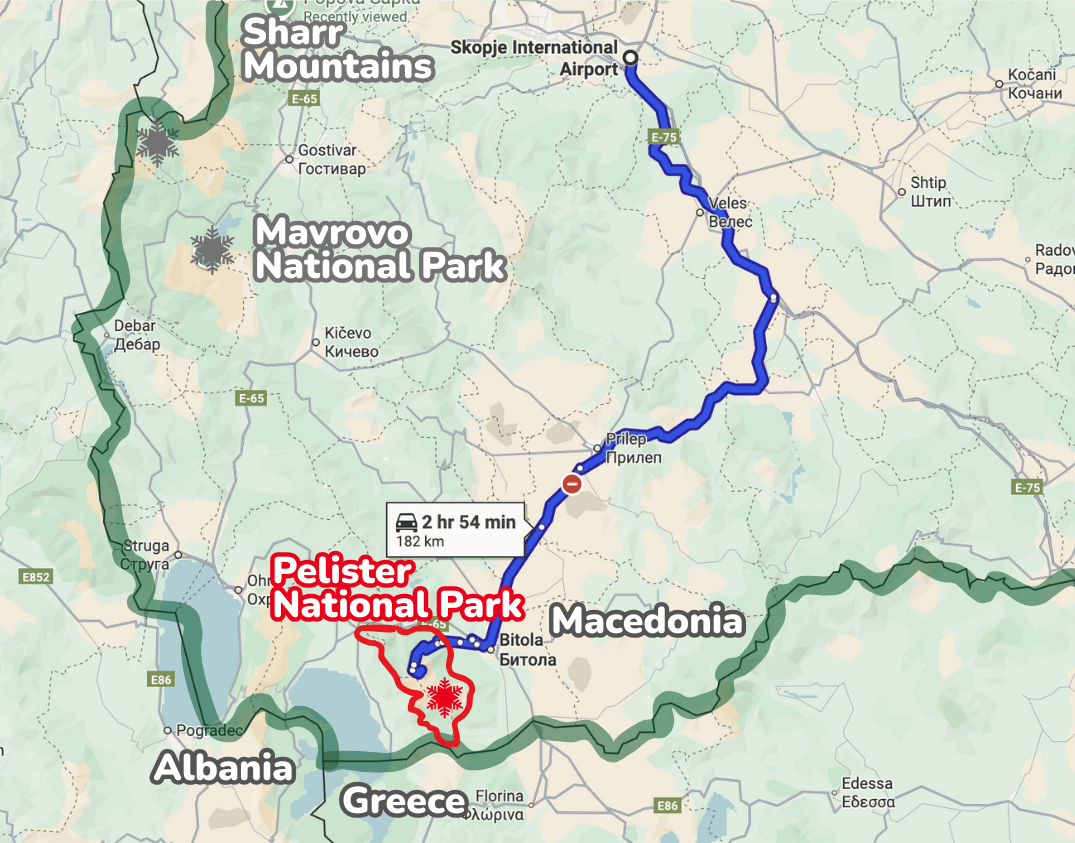
Fly to Skopje, North Macedonia, and then drive to Pelister.
To get to Pelister National Park, fly into Skopje International Airport (SKP), which has connections to major cities throughout Europe.
From Skopje you can then rent a car and drive to Pelister, or if you’re looking for a more sustainable ski-touring experience, you can take a bus to Bitola and arrange a transfer on to Pelister.
For Beginners
Like Mavrovo National Park and the Sharr Mountains, it is recommended that any adventurer heading to Pelister has a base level of fitness, but you certainly don’t need to be an expert ski-tourer to enjoy what the region has to offer.
That being said, it is recommended that a beginner should opt for guiding services or to go with a guided tour. A guide can provide valuable knowledge on avalanche safety, varied terrain, navigation, and equipment, significantly reducing the associated risks.
Beginner-friendly routes
Big Lake Circuit
A gradual ascent through Molika pine forests, featuring scenic glacial lake views, followed by a gentle descent.
Time: 1-2 hours for ascent, ~45 minutes for descent.
Starting point: 📍 Pelister National Park Info Point
Molika Forest Circular Route
Easy ascents and descents through dense Molika pine forests.
Time: 2-3 hours for ascent, ~2 hours for descent.
Starting point: 📍 Pelister National Park Info Point
Pelister Meadows Trail
Gentle, open meadows with stunning views of Lake Prespa.
Time: 2-3 hours for ascent, ~1 hour for descent.
Starting point: 📍 Pelister National Park Info Point
For Experts
Pelister National Park offers unique opportunities for skiing, ranging from 1800m to 2601m, with ski lines catering to intermediate and expert levels, as well as big mountain lines, couloirs, and skiing through the forest, all set against wide panoramic views.
Advanced routes
Mount Pelister Eastern Face (2,601m)
A technical ascent through rugged terrain, followed by a descent through pristine, tree-lined powder.
Elevation gain: ~ 1250m+
Time: 4-5 hours for ascent, ~2 hours for descent.
Starting point: 📍 Pelister National Park Info Point
Big Lake to Golema Reka Traverse
A technical route requiring expert navigation, featuring steep inclines and a challenging descent.
Time: 2-3 hours for ascent, ~2 hours for descent.
Pelister Summit Ridge
A long ascent through exposed ridge lines, followed by a sharp, powder-filled descent.
Elevation gain: ~ 1250m+
Time: 4-5 hours for ascent, ~2 hours for descent.
Starting point: 📍 Pelister National Park Info Point

7 days touring and cat skiing between Kosovo and Macedonia. Local certified guide included. Small groups and limited spots. Departures in January and February. See more on mapotapo.com
Chapter 4: Useful Information
Wheather and snow conditions
Weather patterns in North Macedonia are often unpredictable. However, the region can get up to 2-3 meters of snow during winter. In good seasons, even more. In Popova Šapka, from January through March, you can have weekly snowfalls ranging from 20 to 40 cm, with 2-3 days of precipitation per week. Perturbations usually come from the Adriatic and Aegean seas.
Given the weather unpredictability, knowing how to plan your ski tour based on weather forecasts and knowing when to turn back is crucial. If you choose to go without a guide, it is also recommended to know basic winter survival skills.
You can download the free iOS and Android app Windy, or check the webpage Meteoblue for accurate forecasts.
Avalanche safety
Knowing how to read and interpret avalanche forecasts is critical. Although North Macedonia doesn’t currently have a widespread avalanche monitoring system, it is important to speak to local guides and ski resorts, as they often monitor and report on avalanche risks.
Some more generalised websites like avalanche.org can also help provide real-time avalanche forecasts and information on snow conditions.
Carrying safety equipment, such as beacons, probes, and shovels, is recommended, as is knowledge of some basic rescue techniques.
The ability to read maps and use GPS devices is also very important, as many of the ski-touring routes in North Macedonia are in remote areas. Currently, there are no ski touring guidebooks available, and online resources are scarce. You can still find some user-generated itineraries on Wikilock.
As the region's weather can also change quickly, finding the correct route often becomes significantly more challenging.
Gear
Given the weather and snow conditions, as well as the high chance of encountering fresh powder, it is recommended not to go too thin with your skis. A good 90-95mm, or upward, ski is recommended to make the most out of your powder days.
Never forget your avalanche safety kit, complete with a beacon, shovel, and probe, as well as crampons and an ice axe. They will be helpful for ridges or icy bits.
Although navigation apps are great, it's also a good idea to bring a physical map and compass as a backup, just in case. A headlamp is also recommended.
During your winter trip, expect temperatures to range from 0°C to -20°C. Therefore, it is recommended to pack a thermal base layer, an insulating mid-layer, and waterproof outer layers. Pack heavy gloves and a balaclava for wind protection.
How much will it cost me?
Here is an approximate breakdown of costs you could expect in the region. 👇🏼
Service | Cost | Notes |
|---|---|---|
Guided Tours | €140–€400/day | Most tour prices include guides fee, ski equipment, climbing gear, and avalanche gear. Some guided tours also include the price of accommodation. |
Equipment Rental (without guide) | €30–€45/day | This would be for skis and avalanche gear. |
Accommodation | €20–€80/night | Guesthouses, lodges, or hotels: |
Flights | From London: €60 (return) From Milan: €50 (return) | |
Regional transport | Car rental: €140–€350/week |
